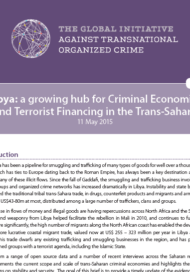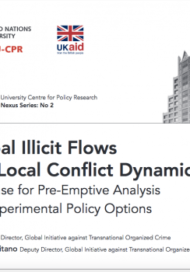Posted on 12 May 2015
The Security Council will vote this week on an EU proposal to allow military action in Libya’s waters to stop the illicit migration across the Mediterranean.
While addressing these flows is a significant and important challenge, interventions off Libya’s coast alone is unlikely to significantly influence the flow of migrants given the extent of the catchment area, and may in fact increase the flow, as the smugglers already pay scant regard for the fates of migrants once they leave Libyan shores.
This policy brief, prepared in collaboration with the Norwegian Centre for Global Analysis, is based on interviews and analysis in the region, takes a closer look at the criminal economies of the trans-Sahara. This indicates that not only is sea-based action going to do little to stop the trade: in fact, it might trigger a greater threat: driving greater profits into the hands of the Islamic State (IS).
Instead, for sustainable solutions, it is vital that interventions to help boat refugees must be accompanied with targeted analysis on how to reduce the profit from smuggling, and to prevent the rescuing of seaborne refugees from supporting IS’s threat finance business model, which may include areas beyond Libya.
Upstream interventions to reduce the motivation for refugees and migrants to enter the organized crime trafficking chain to Libya should be of greater priority. Not only will this reduce the risk of physical harm to the migrants themselves, but it will also significantly impact IS’s largest threat finance opportunity in North Africa. This can best be done by:
- Improving emergency provisions for refugees in Lebanon, Syria, and Jordan by substantially increasing aid provided to, and protection of, refugee camps.
- Promoting campaigns to inform refugees of risks of abuse, slave labor or even death incurred by engaging the services of migrant-smuggling networks.
- Targeting more effectively the smuggling networks and choke points, such as the coast of Lebanon, Sinai, Egypt, and Sudan; or diverting and facilitating migrant flows to land routes. The Sinai should receive particular attention, along with flows from Yemen to this corridor.
- Substantially improving intelligence and analysis on routes, choke points, and organizational structures of the migrant smuggling chain as close as possible to the source countries.
In the long term, reducing the number of refugees fleeing conflict zones is the only solution. However, the measures above are short-term actions which can be taken to prevent an increase in threat finance to radical groups, as well as complete destabilization of Lebanon and Jordan and the subsequent funding of armed groups in Sinai, Egypt and Libya.
Libia: economías criminales y financiación del terrorismo a través del Sahara
El consejo de seguridad votará esta semana una propuesta de la UE para permitir la acción militar en las aguas de Libia destinada a detener la migración ilícita por el Mediterráneo.
Abordar estos flujos representa un desafío importante y considerable, pero es poco probable que sólo las intervenciones en la costa de Libia tengan alguna influencia relevante sobre los flujos migratorios dada la extensión de la zona geográfica de actuación; de hecho, podría aumentarlos ya que a los traficantes les importa muy poco a la vida y al futuro de los migrantes una vez que abandonan las costas libias.
Este informe sobre políticas, preparado en colaboración con el Centro para Análisis Globales de Noruega, está fundado en entrevistas y estudios en la región, y presenta un análisis más detallado de las economías criminales a través del Sahara. Este análisis muestra que las acciones navales no sólo van a hacer poco por detener el comercio, sino que de hecho podrían ser el disparador de una amenaza mayor: el aumento de las ganancias de Estado Islámico (IE).
Por el contrario, para lograr soluciones sostenibles, es vital que las intervenciones navales para ayudar a los refugiados estén acompañadas de un estudio específico que analice las formas de reducir las ganancias por contrabando y de evitar que el rescate de refugiados transportados por mar apoye la estrategia de EI y su modelo de negocio, que puede incluir áreas más allá de Libia.
La prioridad debería estar en realizar intervenciones que empiecen en origen, orientadas a disminuir la motivación de refugiados e inmigrantes de ingresar en la cadena de tráfico ilegal. Esto no sólo reduciría el riesgo de daños físicos a los mismos migrantes, sino que además impactaría considerablemente en la mayor oportunidad que tiene EI de conseguir fondos en América del Norte. Esto puede hacerse mediante:
- La mejora de los suministros de emergencia para los refugiados en el Líbano, Siria y Jordania, aumentando sustancialmente la ayuda y la protección en los campos de refugiados.
- La promoción de campañas para informar a los refugiados sobre los riesgos de abusos, de trabajo esclavo o de incluso muerte en los que incurren al contratar los servicios de redes traficantes de migrantes.
- La dirección efectiva de acciones contra las redes de contrabando y los cuello de botella, como la costa del Líbano, del Sinaí, Egipto y Sudán; o mediante el desvío de los flujos migratorios hacia rutas terrestres. El Sinaí debería recibir especial atención, junto con los flujos desde Yemen a este corredor.
- La mejora sustancial de los trabajos de inteligencia y de análisis sobre las rutas, cuellos de botella, y estructuras organizacionales de la cadena de contrabando de migrantes, lo más cerca posible a los países de origen.
A largo plazo, la única solución es disminuir el número de refugiados que escapan las zonas de conflicto. No obstante, las medidas mencionadas arriba son de corto plazo y pueden ser tomadas para prevenir el crecimiento de los fondos de grupos radicales, como también una desestabilización completa del Líbano y Jordania y el subsiguiente financiamiento de grupos armados en el Sinaí, Egipto y Libia.






